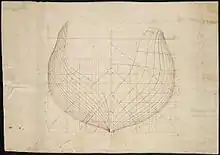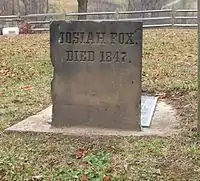Josiah Fox
Josiah Fox (1763–1847) was a British naval architect noted for his involvement in the design and construction of the first significant warships of the United States Navy.

Early years
Fox was born in Falmouth, Cornwall, Kingdom of Great Britain in 1763, and completed the apprenticeship at the Royal Dockyard, Plymouth, where he later served as a shipwright. In 1793 he traveled to the United States to survey timber resources and was there engaged to teach drafting to the sons of Jonathan Penrose, an American shipwright.
Philadelphia Naval Shipyard
On 17 July 1794 Fox signed and as a Quaker "affirmed" his support of the Constitution of the United States.[1] Fox was initially employed at $500.00 per year by the US Navy as a clerk draftsman working under Naval Constructor Joshua Humphreys at Philadelphia Naval Shipyard. Humphreys was the designer of the first Navy frigates. Fox and Humphreys disagreed over design issues, the former believing that the designs were too long and had too sharp a bow, among other problems. This disagreement caused significant animosity between the two, with arguments over credit for the design continuing in the press as late as 1827.
Gosport Navy Yard
On 1 August 1798, Fox was appointed Navy Constructor to superintend the building of the frigate Chesapeake, 38, which was to be built in Norfolk. Fox's salary was set at $2 000 per annum.[2] Fox apparently altered Humphreys’ design to his own liking, though this may have been partially the result of a timber shortage. The Chesapeake turned out to be less impressive a sailor than the other early frigates, had a reputation as an unlucky ship, and was captured by HMS Shannon in 1813.
Washington Navy Yard
In the first years of the 19th century, Fox was responsible for fitting out some of the gunboats that were the Republican Jefferson Administration's unsuccessful attempt at creating a "Naval Militia." In 1804, secretary of the Navy, Robert Smith sent for Fox to come to Washington, D.C. and convinced him to become the naval constructor at the Washington Navy Yard. Smith endorsed Fox as " a scientific as well as a practical man,[who] stands high among the first in his profession." [3] At that navy yard Fox was to superintend the construction and repair of naval vessels. Thomas Tingey had overall charge of the yard and its employees, however, as naval constructor, Fox reported to the secretary of the Navy and directed the largest and most skilled group of mechanics and laborers. Fox's salary as constructor for the WNY was increased to a generous $2000.00 per annum with $500.00 additional allowance for housing, and the liberty of taking as many apprentices as he chose. During these years, Fox designed the sloop of war USS Wasp and oversaw major repairs to the frigates USS United States, President and Essex. Despite the navy yard's progress in building and repairing vessels, Fox's relationship with Commodore Tingey deteriorated over time. Tingey believed in discipline, and deference to authority and was a firm believer in the chain of command. Fox on the other hand considered his appointment by the secretary of the Navy sufficient to ignore yard policy when it suited. By 1806 each man was complaining to the secretary about the other. While the two had differing personalities a substantial part of their dilemma was the confusing reporting relationships. Tingey had overall charge of the shipyard but Fox was hired by and reported directly to the secretary of the Navy. One proof of the structural nature of this problem is that William Doughty Fox's successor, experienced similar difficulties in his dealing with both Tingey and the subsequent Commandant Isaac Hull.[4]
Another source of disagreement was Fox's attempt to better organize his workforce of mechanics and laborers along more rational lines. As part of this effort, Fox wrote some of the first standardized job descriptions and expanded the apprenticeship program. Fox although a member of the Society of Friends or "Quakers" not only worked for the military but was a slaveholder. In 1803/1804 probably while working in the Gosport Navy Yard, Fox purchased three enslaved individuals Edwin Jones, William Oakley and Betsey. Doynes. While in Washington DC the Fox family utilized Betsey Doynes as a servant and cook, Fox to the alarm of his white workforce, broke with custom and entered Jones and Oakley as apprentice carpenters. In 1808 slaves made up about one third of the WNY workforce [5] Most of the enslaved worked as laborers or blacksmith strikers so Fox's decision to apprentice both Jones and Oakley in the elite ship-carpenter trade outraged the already anxious white mechanics.
Among the changes Fox endorsed were controls on waste and pilferage and he urged his master mechanics to be "careful to prevent the Timber Materials and other of the Public property in the Timber Materials and other of the Public property in the Carpenters Department from being improperly expended, Wantonly destroyed, Wasted, Injured or pillaged - He will not permit any alteration whatever to be made in any part of the Ships whilst under repair without express orders being given for that purpose."
Concerned about the dangers of fire he cautioned his workers regarding the danger of fire to: "take care that no Fires be made by the Carpenters and others attached to them to Bend their planks but at such places as may be deemed to be most proper for that careful purpose, and he is charged to see them all extinguished by Sunset." Fox even went as far as to urge his employees to remember and care for their environment and to avoid throwing debris in the Potomac and Anacostia Rivers. He urged his men: "When working afloat he is not on any authority whatever to throw over board into the River any Stage Plank & Spalls, or other useful materials, neither is he to throw any rotten stuff that will sink to the injury of the river."
These changes and proposals were met with wide skepticism for many employees thought Fox's Quaker notions of economy and simplicity would only reduce their hours of work. Yet another cause of friction centered about his move to stop or reduce some popular practices such as breaks for whiskey and grog which many shipyards tolerated. Perhaps though in the end it was Fox's ardent Federalism which gradually lost him the support of Thomas Jefferson and James Madison. Madison's new secretary of Navy, Paul Hamilton, probably on Tingey's recommendation "unceremoniously and perhaps unjustly" dismissed Fox.[6] Hamilton again probably at Tingey's bidding directed that all of Fox's white apprentices be kept on the yard rolls if possible and the blacks dismissed [Sharp]. In December 1809 prior to leaving the District of Columbia for Ohio, Fox manumitted Edwin Jones, William Oakley and prospectively manumitted Betsey Doynes.[7]
Fox died in 1847 and was buried in the cemetery near the Concord Hicksite Friends Meeting House, near Colerain.
Quaker family links

Fox, a Quaker, married Anne Miller of Philadelphia and had 10 children. He had been disowned from his Quaker Meeting for his involvement in the construction of warships, but was reinstated after the War of 1812. In 1814, Fox and his family settled in Colerain, Belmont County, Ohio, located in south-eastern Ohio.
Josiah Fox and two of his sons visited Cornwall in September 1833, to take possession of the property of his deceased brother, John. On Sunday 8 September, he met one of his relations, Barclay Fox, who recorded the meeting enthusiastically in his journal. On the next day, they met by chance at Falmouth Docks, which Josiah and his sons were inspecting.[8]
References
- Sharp, John G. Early Loyalty and Citizenship Requirements for Federal Employees at Gosport and other Naval Shipyards http://www.usgwarchives.net/va/portsmouth/shipyard/nnysharp.html#loyalty
- Westlake Merle Josiah Fox 1763-1847Xlibris Books 2003, p.49
- Brown, Gordon S. The Captain Who Burned His Ships Captain Thomas Tingey, USN 1750 -1829 (Naval Institute Press: Annapolis 2011), p.100.
- Sharp, John G. Josiah Fox Naval Architect http://genealogytrails.com/washdc/biographies/bio2.html#Josiah_Fox
- Sharp John G. editor Diary of Michael Shiner 1813 -1869 https://www.history.navy.mil/research/library/online-reading-room/title-list-alphabetically/d/diary-of-michael-shiner/introduction.html
- Brown, Gordon S., The Captain Who Burned His Ships Captain Thomas Tingey, USN, 1750 -1829 Naval Institute Press: Annapolis, 2011 pp 76–78
- Liber X, no 23 1809 Folio 279 & 280 District of Columbia Deed Books
-
Fox, Robert Barclay (1979). Raymond Brett (ed.). Barclay Fox's journal. London: Bell and Hyman. ISBN 0-7135-1865-0.
and U.S. Fox, Robert Barclay (1979). Raymond Brett (ed.). Barclay Fox's journal. Totowa, N.J.: Rowman & Littlefield. ISBN 0-8476-6187-3. Pages 55 and 56.
Bibliography
- Toll, Ian (2006). Six Frigates: the Epic History of the Founding of the U.S. Navy. New York: W. W. Norton. ISBN 0-393-05847-6.
- Westlake Merle Josiah Fox 1763-1847 Xlibris Books 2003, p. 49
- "Ferry Landing, Fall 2003". Martin Ferry Area Historical Society. Retrieved 4 December 2006.
